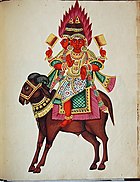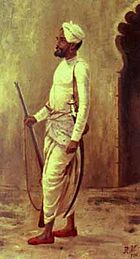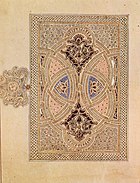History of painting
The history of painting through time and crosses all cultures.
Prehistoric Painting

Painting a horse in the cave of Lascaux in France
The oldest paintings known to date are in the Grotte Chauvet in France and they have, according to most historians, about 32 000 years. Carved and painted with the red ocher and dye black, they are mostly hunting scenes with horses, rhinos, lions, buffalo and man. There are other examples of rock art around the world, in France, in Spain, in Portugal, in China, in Australia, etc..
Multiple hypotheses have been advanced as to the meaning of these paintings. Some imagine that prehistoric people painted animals to "catch" their soul or spirit to hunt them more easily. Others think it is a vision animist and homage to surrounding nature. We may also consider that these paintings are the result of a basic need and an innate expression or else they are a means of transmitting information.
Nevertheless, it is undeniable that prehistory has seen the emergence of the painting, an art form which was then distributed worldwide.
Eastern Painting
Painting of South Asia
Indian Painting
The Indian paintings have always been oriented towards the representation of gods and religious lords. The Indian art includes various schools of art that have existed in the Indian subcontinent. Indian painting has evolved from large frescoes of Ellora to paint miniatures of the Mughal Empire and work on the metal of the school Tanjore. The paintings of Gandhar - Taxila are influenced by the Persian works in the west. The current of Oriental painting was mostly developed around the art school of Nalanda. The work is mostly inspired by scenes from Indian mythology.
A fresco from the Ajanta cave
The earliest Indian paintings were the rock paintings of prehistoric times, as the petroglyphs found in such shelters rock-of Bhimbetka, some of which are dated to 5500 BC. This form of painting has evolved over the centuries and one can find an example of Indian paintings refined, made the seventh century in the caves of Ajanta in the state of Maharashtra.

Representation of Agni, the fire goddess
Madhubani Painting: This style of painting was born in the region of Mithila in the state of Bihar. The origins of Madhubani painting back to the ancient, and according to tradition, it would have appeared at the same time as the Ramayana, when King Janaka was asked artists to depict the marriage of his daughter Sita with Rama, which is considered as an incarnation of the Hindu Lord Vishnu.
Rajput painting: it is a style of Indian painting that arose in the eighteenth century, in the royal courts of Rajputana (ancient name of Rajasthan).

Painting of a soldier Rajput
Each kingdom has developed a particular style, but with certain common characteristics. Rajput paintings depict a number of themes, events of epics like the Ramayana or Mahabharata, the life of Krishna, beautiful landscapes and people. The miniatures were the media's favorite style of painting, but several manuscripts also contain Rajput paintings, and there are also paintings on the walls and inside the palace, as the Haveli of Shekhawait.
Mughal Paintings: Mughal painting is a special type of Indian painting, generally confined to illustrations on the books and miniatures.
Tanjore painting representing the Sikh Gurus.
Paintings of Tanjore: Tanjore Painting is an important form of classical painting of South India, was born the city of Tanjore in the state of Tamil Nadu. This art form dates from the ninth century, a period dominated by the governors of Chola who encouraged art and literature. These paintings are known for their elegance, rich colors and attention to detail. The themes are generally gods and goddesses and scenes from Hindu mythology.
The school Madras: During the British colonial period, the crown found that the city of Madras brought together artists and intellectuals among the brightest in the world. The city was chosen to establish an institute to supply the Royal Court in London in artistic works. Thus was born the Madras school. At first traditional artists were hired to perform a wide variety of fine furniture, wrought metal and curiosities that were sent to the royal palace of the queen.
The school of Bengal: It is an influential artistic movement that flourished in India during the British Raj in the early twentieth century. It was associated with Indian nationalism, but it has also been supported by many British arts administrators.
Painting of Islam

Painting on paper Yahya ibn Mahmud al-Wasit, Iraq (1237)

Ornament on the Quran
The Islam forbids representation of human beings, animals and all the items on the believers to avoid the idolatry which explains that in principle there is no religious painting (or sculpture) in Muslim culture. Long visual art has therefore limited the arabesques, often abstract, with geometrical configuration or floral. Usually related to the architecture and calligraphy, painting Islam is reflected in the painting tiles in mosques or in illuminations of the Koran and other books.
In fact, the abstract art is not an invention of the modern art, but it was present in cultures pre-classical and non-Western many centuries before and was essentially a decorative art. Art Nouveau, with Aubrey Beardsley and the architect Antonio Gaudi, has reintroduced abstract floral patterns into western art.
However, despite the taboo of figurative representation, few Muslim countries have cultivated a rich pictorial tradition, not in the form of tables, but rather as a means to illustrate messages. Thus the Iranian or Persian art, mostly known through the Persian miniature, concentrates on the illustration of epic or romantic events in the literature. Persian illustrators deliberately avoided the use of shadow and light or the perspective to observe the rule of not creating an illusion of reality too realistic. Their goal was not to portray the world as it is, but to represent images of an ideal world of timeless beauty and perfect order.
.JPG/180px-Aurangabad_-_Ajanta_Caves_(13).JPG)